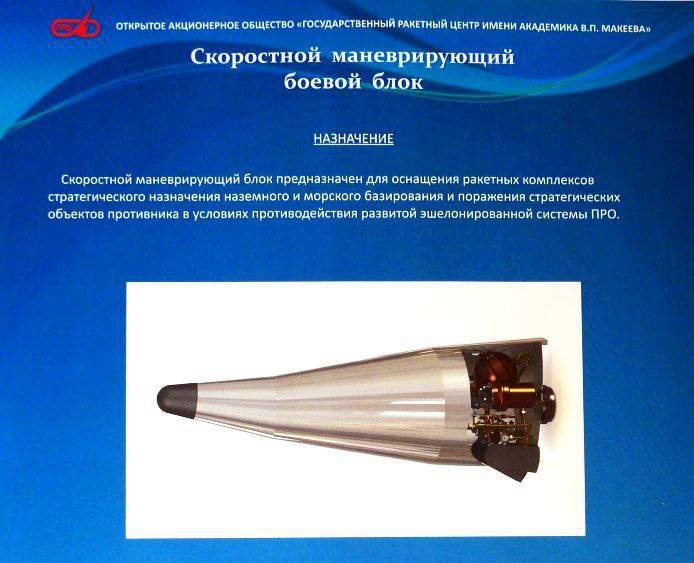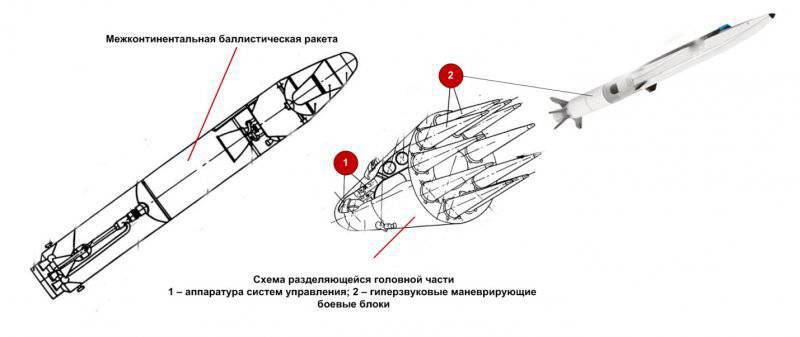A few words about the new heavy rocket
Fig. from vpk
While on the Internet and in the corridors of the State Department (which is similar in terms of thinking), useless disputes about bilateral violations of the INF Treaty by the United States and Russia do not abate, which, without having any documentary evidence (with the exception of the American "targets"), looks pretty silly , the community has lagged slightly behind future changes in the field of global deterrence, relying only on existing developments. Incredible including the unsubstantiated claims of the States (including the September ones), although the extreme launch of the "Boundary" to the "necessary" range has put everything into as far as possible.
The current concept of the conduct of hostilities of the United States and NATO provides for the achievement of the maximum number of goals of a war or conflict extremely quickly and as efficiently as possible. In this vein, most samples of so-called. "smart weapons", high-precision weapons and weapons of rapid global strike." Characteristic features of the future use of such weapons are the speed of delivery to the target, controlled escalation of the conflict (to ensure the maximum reduction in the likelihood of reciprocal use of WMD), high accuracy and greater combat effectiveness of use (ideally: one shot - one hit target).
Despite the presence in the Doctrine of the Russian Federation of a postulate on the use of nuclear weapons in response to aggression with the use of conventional weapons, it also indicates that such an application is possible only if the state itself is threatened. Of course, in the conditions of the opening of a massive missile launch by the Russian warning system, the retaliatory strike will be carried out immediately. However, in conditions of a gradual increase in the intensity of the conflict, the choice of the moment and methods of strikes with strategic weapons is considerably difficult and, first of all, this is due to the undesirability of the escalation of the conflict into a nuclear one without the threat from the enemy to realize "total destruction".
Naturally, from a certain moment, the use of tactical nuclear weapons and strategic non-nuclear weapons, such as CD X-101, will begin. However, such a weapon in a conflict of medium intensity is not a panacea either. Tactical nuclear weapons solve tactical tasks. At the same time, the main blow will be to targets in Europe, but the structure of the state of the likely overseas enemy will not suffer. Non-nuclear cruise missiles are still insufficient and they possess a number of vulnerabilities of this class of weapons.
At the same time, the currently existing ICBM missile systems cannot solve problems in this phase of conflict development, since everyone has nuclear equipment. Although they have a number of fundamental advantages - a short time from the decision to launch, a short time to deliver the ammunition to the target, high reliability of delivery (lack of influence of enemy air defenses, high probability of overcoming missile defense using modern PCB facilities).
To expand the capabilities of the Russian Federation in such conditions, it was decided to equip the new heavy rocket being developed with non-nuclear military equipment. What some real and former military leaders have already mentioned in passing.
However, the principal novelty is not to put a high-explosive or fragmentation part on the rocket - this is too expensive and ineffective, especially for a heavy missile system.
As a result of the joint work of military and defense industry specialists, a fundamentally new solution was proposed. The novelty lies in the high combat effectiveness due to the merging of the three technologies: classical rocket, hypersonic planning and a fundamentally new warhead. All these technologies exist and are tested. Now they are being put into practice. The synthesis of technology promises to generate a very formidable and multifunctional weapon.
Rocket technologies exist and have been worked out for a long time. The design of a new heavy rocket is based on time-tested solutions and has all the advantages of such rockets. In addition, the removability of combat equipment will provide both the possibility of using classical nuclear BB and new warheads. This will ensure greater flexibility of combat use in various conditions of the situation and the development of military conflict.
The rocket is planned to be equipped with several third-generation hypersonic maneuvering units, the work on which is now being conducted in parallel with the already flying products of the second generation, which are currently undergoing tests for another RK. The first was the Albatross. The products of the second generation, now undergoing tests, are flying, but still have a number of fundamental childhood diseases of the new technology. In the third generation, the experience of failures has already been taken into account, new construction materials and SUs have been used on a new element base.

The movement of the data of the aircraft is not recorded by the enemy SPRIAU, as the flight takes place below the radar of the action radar. The rocket will practically not leave the atmosphere, which will create difficulties not only for the ground level of the SPRNU, but also for the space one. And maneuvering blocks and bypassing the missile / air defense zones will prevent the calculation of the aiming point and the defeat of the blocks on the approach to the target.
The principal difference from the previously existing samples of such systems is a significant reduction in size and weight due to the use of new SU and new materials, which will allow to place on the rocket several such devices.
But the real "highlight" of the complex will be several versions of its CU. Along with the classic nuclear warheads of various capacities, a completely new one will be used. Previously, systems on such principles in the world have not been applied. Given that this warhead is non-nuclear, the effectiveness of its use is comparable to the use of ultra-low-power nuclear charge and far exceeds the use of the most powerful explosives. The kinetics makes an additional contribution to the power of the explosion, which is unattainable when using classical CDs with their warheads. Work on this topic is carried out in a very limited cooperation, with the integration of the results and the military and strategic justification is carried out by the 4 Central Research Institute of the Ministry of Defense. Naturally, the technical details of this work were not communicated not only to the Strategic Missile Forces Headquarters, but also to us, however, some of the stated and confirmed key capabilities of this system are really impressive.
It is hoped that at the new stage of the development of rocket technologies, the presence in service of several heavy missiles in the Shlyambur variant of equipment will make it possible to carry out along with nuclear effective non-nuclear destruction of fortified objects, command posts, power plants, dams and other especially important objects on the territory of the enemy with high probability and in the shortest possible time, which will significantly influence the armed conflict at various stages of its development.

Information